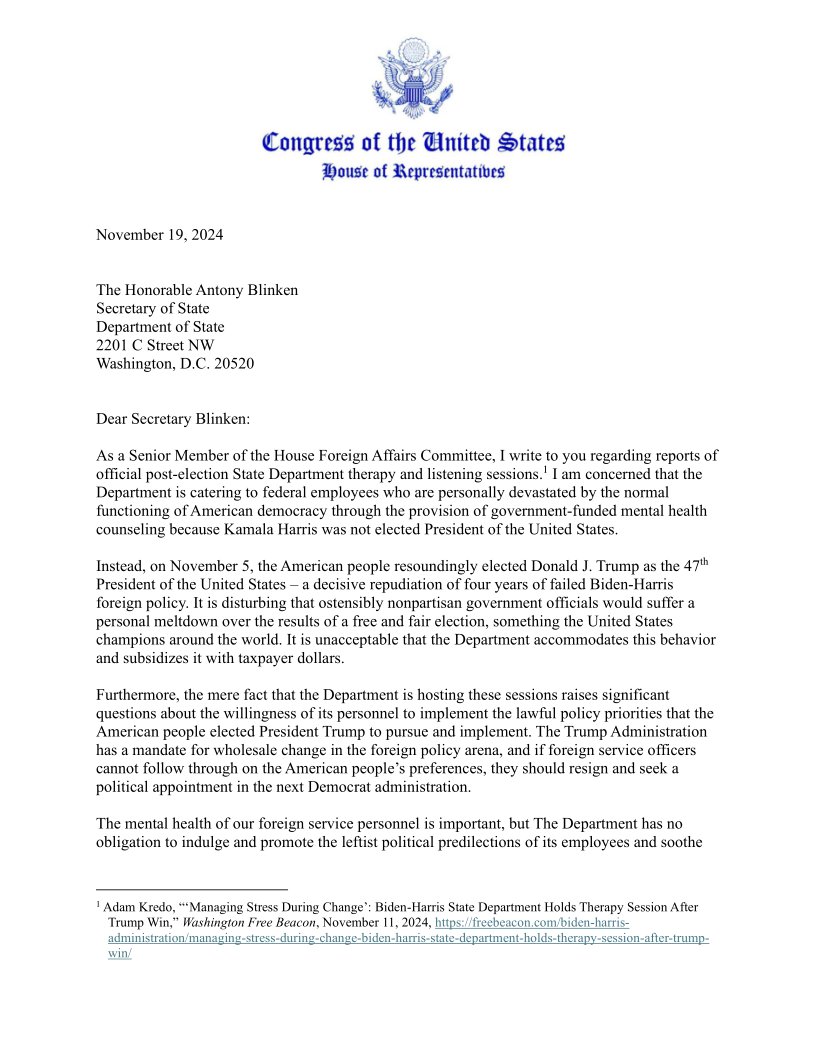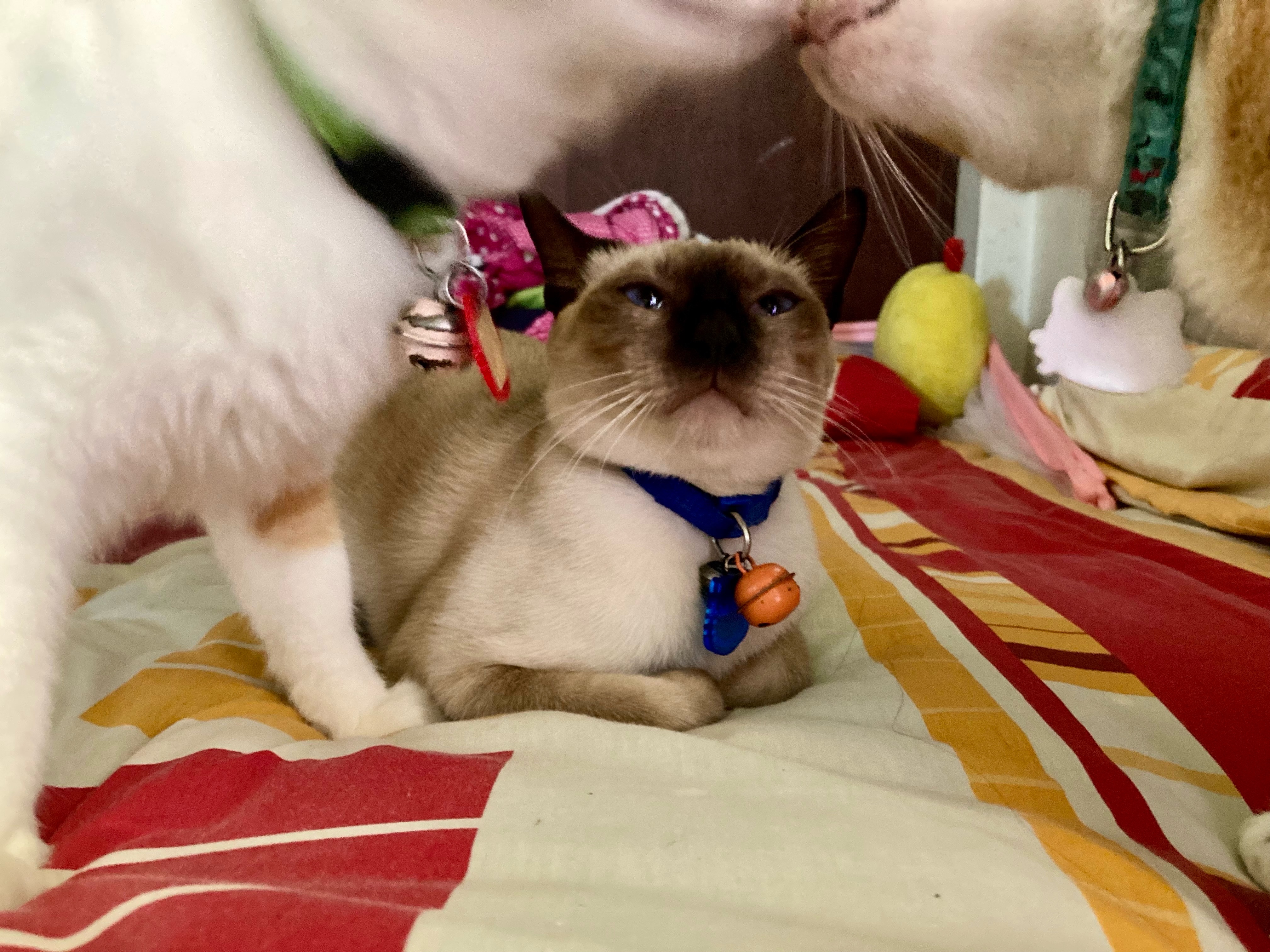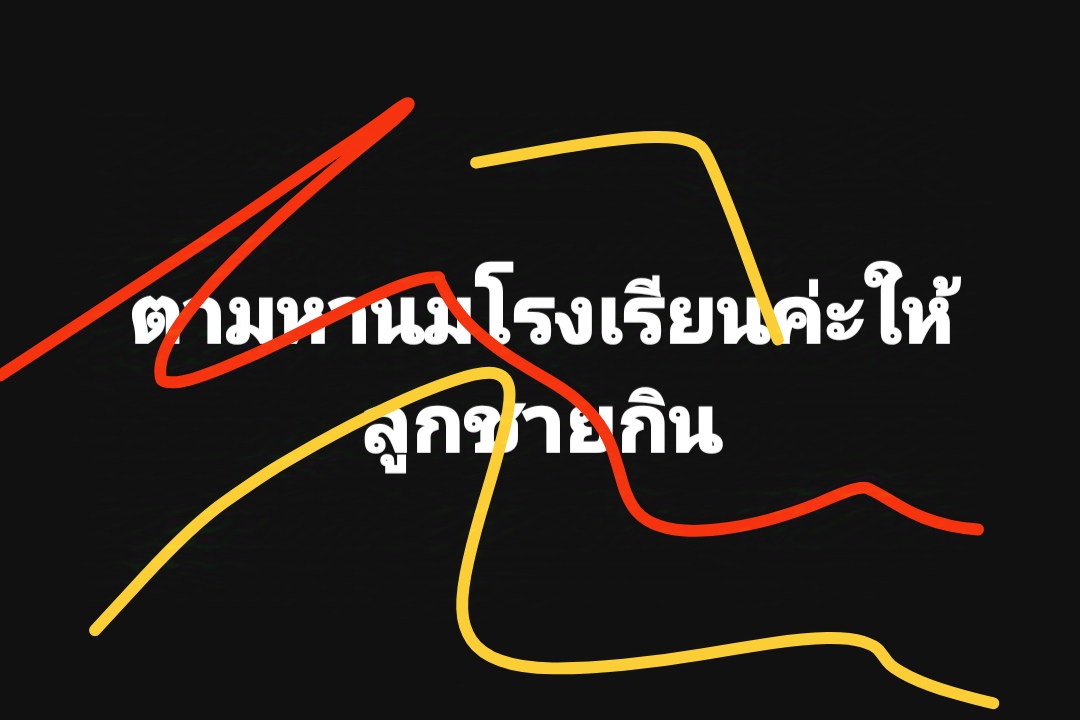BLINKEN กำลังโดนโจมตีจาก "CRY SESSIONS" ที่กระทรวงการต่างประเทศ – รายงาน
แอนโธนี บลิงเคน รัฐมนตรีต่างประเทศสหรัฐฯ ตกเป็นเป้าวิพากษ์วิจารณ์ หลังจากมีรายงานว่า กระทรวงการต่างประเทศได้จัดการประชุมบำบัดให้กับพนักงานที่รู้สึกไม่สบายใจกับชัยชนะในการเลือกตั้งของ โดนัลด์ ทรัมป์ ในปี ๒๐๒๔ นักวิจารณ์ตั้งคำถามถึงการใช้เงินภาษีของประชาชนในการประชุมดังกล่าว, ซึ่งรายงานว่ามีจุดมุ่งหมายเพื่อช่วยให้พนักงานรับมือกับการกลับมาดำรงตำแหน่งของทรัมป์
“พวกนี้เป็นเจ้าหน้าที่กระทรวงการต่างประเทศของสหรัฐฯ! พวกเขาจะจัดการกับศัตรูต่างชาติอย่างไรหากพวกเขาไม่สามารถจัดการกับประชาธิปไตยได้?” เคย์ลีห์ แมคเอแนนี พิธีกรร่วมของ Fox News ถาม “รายงานฉบับใหม่ระบุว่า กระทรวงการต่างประเทศใช้เงินภาษีของประชาชน—เงินของคุณ—เพื่อจัดหาเงินทุนสำหรับการบำบัดพนักงานหลังจากที่ทรัมป์ได้รับชัยชนะ พวกนี้เป็นพนักงานของรัฐบาลกลาง,” เธอกล่าวเสริม
ส.ส. ดาร์เรล อิสซา, จากรัฐแคลิฟอร์เนีย แสดงความกังวลในจดหมายถึงบลิงเคน โดยระบุว่า “เป็นเรื่องน่ากังวลที่เจ้าหน้าที่รัฐที่แม้จะเป็นกลางกลับต้องประสบกับวิกฤตส่วนตัวจากผลการเลือกตั้งที่เสรีและยุติธรรม, ซึ่งเป็นสิ่งที่สหรัฐฯผลักดันไปทั่วโลก”
อิสซาวิพากษ์วิจารณ์ความคิดริเริ่มดังกล่าวเพิ่มเติม, โดยเขียนว่า,
“ฉันกังวลที่กระทรวงกำลังเอาใจพนักงานของรัฐบาลกลาง ซึ่งรู้สึกหดหู่ใจกับการทำงานตามปกติของประชาธิปไตยในอเมริกาผ่านการให้คำปรึกษาด้านสุขภาพจิต ที่ได้รับเงินสนับสนุนจากรัฐบาล เนื่องจาก กมลา แฮร์ริส ไม่ได้รับเลือกเป็นประธานาธิบดีแห่งสหรัฐอเมริกา”
ในจดหมายของเขา, อิสซายังเรียกร้องความโปร่งใสเกี่ยวกับเซสชันต่างๆ, รวมไปถึงค่าใช้จ่าย, วัสดุที่ใช้, และว่าเคยเกิดแนวทางปฏิบัติที่คล้ายคลึงกันในอดีตหรือไม่
.
BLINKEN UNDER FIRE FOR "CRY SESSIONS" AT THE STATE DEPARTMENT – REPORTS
US Secretary of State Antony Blinken is under scrutiny following reports that the State Department organized therapy sessions for employees distressed by Donald Trump’s 2024 election victory. Critics are questioning the use of taxpayer funds for these sessions, which were reportedly aimed at helping staff cope with Trump’s return to office.
“These are foreign service officers of the United States! How do they handle foreign adversaries if they can’t handle democracy?” asked Fox News co-host Kayleigh McEnany. “A new report claims that the State Department used taxpayer dollars—your money—to fund therapy sessions for employees after Trump's win. These are federal employees,” she added.
Rep. Darrell Issa, R-Calif., expressed concern in a letter to Blinken, stating, “It is disturbing that ostensibly nonpartisan government officials would suffer a personal meltdown over the results of a free and fair election, something the United States champions around the world.”
Issa further criticized the initiative, writing, “I am concerned that the Department is catering to federal employees who are personally devastated by the normal functioning of American democracy through the provision of government-funded mental health counseling because Kamala Harris was not elected President of the United States.”
In his letter, Issa also demanded transparency regarding the sessions, including their cost, materials used, and whether similar practices have occurred in the past.
.
10:27 AM · Nov 25, 2024 · 3,797 Views
https://x.com/SputnikInt/status/1860888099116503049
แอนโธนี บลิงเคน รัฐมนตรีต่างประเทศสหรัฐฯ ตกเป็นเป้าวิพากษ์วิจารณ์ หลังจากมีรายงานว่า กระทรวงการต่างประเทศได้จัดการประชุมบำบัดให้กับพนักงานที่รู้สึกไม่สบายใจกับชัยชนะในการเลือกตั้งของ โดนัลด์ ทรัมป์ ในปี ๒๐๒๔ นักวิจารณ์ตั้งคำถามถึงการใช้เงินภาษีของประชาชนในการประชุมดังกล่าว, ซึ่งรายงานว่ามีจุดมุ่งหมายเพื่อช่วยให้พนักงานรับมือกับการกลับมาดำรงตำแหน่งของทรัมป์
“พวกนี้เป็นเจ้าหน้าที่กระทรวงการต่างประเทศของสหรัฐฯ! พวกเขาจะจัดการกับศัตรูต่างชาติอย่างไรหากพวกเขาไม่สามารถจัดการกับประชาธิปไตยได้?” เคย์ลีห์ แมคเอแนนี พิธีกรร่วมของ Fox News ถาม “รายงานฉบับใหม่ระบุว่า กระทรวงการต่างประเทศใช้เงินภาษีของประชาชน—เงินของคุณ—เพื่อจัดหาเงินทุนสำหรับการบำบัดพนักงานหลังจากที่ทรัมป์ได้รับชัยชนะ พวกนี้เป็นพนักงานของรัฐบาลกลาง,” เธอกล่าวเสริม
ส.ส. ดาร์เรล อิสซา, จากรัฐแคลิฟอร์เนีย แสดงความกังวลในจดหมายถึงบลิงเคน โดยระบุว่า “เป็นเรื่องน่ากังวลที่เจ้าหน้าที่รัฐที่แม้จะเป็นกลางกลับต้องประสบกับวิกฤตส่วนตัวจากผลการเลือกตั้งที่เสรีและยุติธรรม, ซึ่งเป็นสิ่งที่สหรัฐฯผลักดันไปทั่วโลก”
อิสซาวิพากษ์วิจารณ์ความคิดริเริ่มดังกล่าวเพิ่มเติม, โดยเขียนว่า,
“ฉันกังวลที่กระทรวงกำลังเอาใจพนักงานของรัฐบาลกลาง ซึ่งรู้สึกหดหู่ใจกับการทำงานตามปกติของประชาธิปไตยในอเมริกาผ่านการให้คำปรึกษาด้านสุขภาพจิต ที่ได้รับเงินสนับสนุนจากรัฐบาล เนื่องจาก กมลา แฮร์ริส ไม่ได้รับเลือกเป็นประธานาธิบดีแห่งสหรัฐอเมริกา”
ในจดหมายของเขา, อิสซายังเรียกร้องความโปร่งใสเกี่ยวกับเซสชันต่างๆ, รวมไปถึงค่าใช้จ่าย, วัสดุที่ใช้, และว่าเคยเกิดแนวทางปฏิบัติที่คล้ายคลึงกันในอดีตหรือไม่
.
BLINKEN UNDER FIRE FOR "CRY SESSIONS" AT THE STATE DEPARTMENT – REPORTS
US Secretary of State Antony Blinken is under scrutiny following reports that the State Department organized therapy sessions for employees distressed by Donald Trump’s 2024 election victory. Critics are questioning the use of taxpayer funds for these sessions, which were reportedly aimed at helping staff cope with Trump’s return to office.
“These are foreign service officers of the United States! How do they handle foreign adversaries if they can’t handle democracy?” asked Fox News co-host Kayleigh McEnany. “A new report claims that the State Department used taxpayer dollars—your money—to fund therapy sessions for employees after Trump's win. These are federal employees,” she added.
Rep. Darrell Issa, R-Calif., expressed concern in a letter to Blinken, stating, “It is disturbing that ostensibly nonpartisan government officials would suffer a personal meltdown over the results of a free and fair election, something the United States champions around the world.”
Issa further criticized the initiative, writing, “I am concerned that the Department is catering to federal employees who are personally devastated by the normal functioning of American democracy through the provision of government-funded mental health counseling because Kamala Harris was not elected President of the United States.”
In his letter, Issa also demanded transparency regarding the sessions, including their cost, materials used, and whether similar practices have occurred in the past.
.
10:27 AM · Nov 25, 2024 · 3,797 Views
https://x.com/SputnikInt/status/1860888099116503049
🔥 BLINKEN กำลังโดนโจมตีจาก "CRY SESSIONS" ที่กระทรวงการต่างประเทศ – รายงาน
แอนโธนี บลิงเคน รัฐมนตรีต่างประเทศสหรัฐฯ ตกเป็นเป้าวิพากษ์วิจารณ์ หลังจากมีรายงานว่า กระทรวงการต่างประเทศได้จัดการประชุมบำบัดให้กับพนักงานที่รู้สึกไม่สบายใจกับชัยชนะในการเลือกตั้งของ โดนัลด์ ทรัมป์ ในปี ๒๐๒๔ นักวิจารณ์ตั้งคำถามถึงการใช้เงินภาษีของประชาชนในการประชุมดังกล่าว, ซึ่งรายงานว่ามีจุดมุ่งหมายเพื่อช่วยให้พนักงานรับมือกับการกลับมาดำรงตำแหน่งของทรัมป์
💬 “พวกนี้เป็นเจ้าหน้าที่กระทรวงการต่างประเทศของสหรัฐฯ! พวกเขาจะจัดการกับศัตรูต่างชาติอย่างไรหากพวกเขาไม่สามารถจัดการกับประชาธิปไตยได้?” เคย์ลีห์ แมคเอแนนี พิธีกรร่วมของ Fox News ถาม “รายงานฉบับใหม่ระบุว่า กระทรวงการต่างประเทศใช้เงินภาษีของประชาชน—เงินของคุณ—เพื่อจัดหาเงินทุนสำหรับการบำบัดพนักงานหลังจากที่ทรัมป์ได้รับชัยชนะ พวกนี้เป็นพนักงานของรัฐบาลกลาง,” เธอกล่าวเสริม
✍️ ส.ส. ดาร์เรล อิสซา, จากรัฐแคลิฟอร์เนีย แสดงความกังวลในจดหมายถึงบลิงเคน โดยระบุว่า 🤣“เป็นเรื่องน่ากังวลที่เจ้าหน้าที่รัฐที่แม้จะเป็นกลางกลับต้องประสบกับวิกฤตส่วนตัวจากผลการเลือกตั้งที่เสรีและยุติธรรม, ซึ่งเป็นสิ่งที่สหรัฐฯผลักดันไปทั่วโลก”🤣
✍️ อิสซาวิพากษ์วิจารณ์ความคิดริเริ่มดังกล่าวเพิ่มเติม, โดยเขียนว่า, 🤣
“ฉันกังวลที่กระทรวงกำลังเอาใจพนักงานของรัฐบาลกลาง ซึ่งรู้สึกหดหู่ใจกับการทำงานตามปกติของประชาธิปไตยในอเมริกาผ่านการให้คำปรึกษาด้านสุขภาพจิต ที่ได้รับเงินสนับสนุนจากรัฐบาล เนื่องจาก กมลา แฮร์ริส ไม่ได้รับเลือกเป็นประธานาธิบดีแห่งสหรัฐอเมริกา”🤣
ในจดหมายของเขา, อิสซายังเรียกร้องความโปร่งใสเกี่ยวกับเซสชันต่างๆ, รวมไปถึงค่าใช้จ่าย, วัสดุที่ใช้, และว่าเคยเกิดแนวทางปฏิบัติที่คล้ายคลึงกันในอดีตหรือไม่
.
🔥 BLINKEN UNDER FIRE FOR "CRY SESSIONS" AT THE STATE DEPARTMENT – REPORTS
US Secretary of State Antony Blinken is under scrutiny following reports that the State Department organized therapy sessions for employees distressed by Donald Trump’s 2024 election victory. Critics are questioning the use of taxpayer funds for these sessions, which were reportedly aimed at helping staff cope with Trump’s return to office.
💬 “These are foreign service officers of the United States! How do they handle foreign adversaries if they can’t handle democracy?” asked Fox News co-host Kayleigh McEnany. “A new report claims that the State Department used taxpayer dollars—your money—to fund therapy sessions for employees after Trump's win. These are federal employees,” she added.
✍️ Rep. Darrell Issa, R-Calif., expressed concern in a letter to Blinken, stating, “It is disturbing that ostensibly nonpartisan government officials would suffer a personal meltdown over the results of a free and fair election, something the United States champions around the world.”
✍️ Issa further criticized the initiative, writing, “I am concerned that the Department is catering to federal employees who are personally devastated by the normal functioning of American democracy through the provision of government-funded mental health counseling because Kamala Harris was not elected President of the United States.”
In his letter, Issa also demanded transparency regarding the sessions, including their cost, materials used, and whether similar practices have occurred in the past.
.
10:27 AM · Nov 25, 2024 · 3,797 Views
https://x.com/SputnikInt/status/1860888099116503049






















